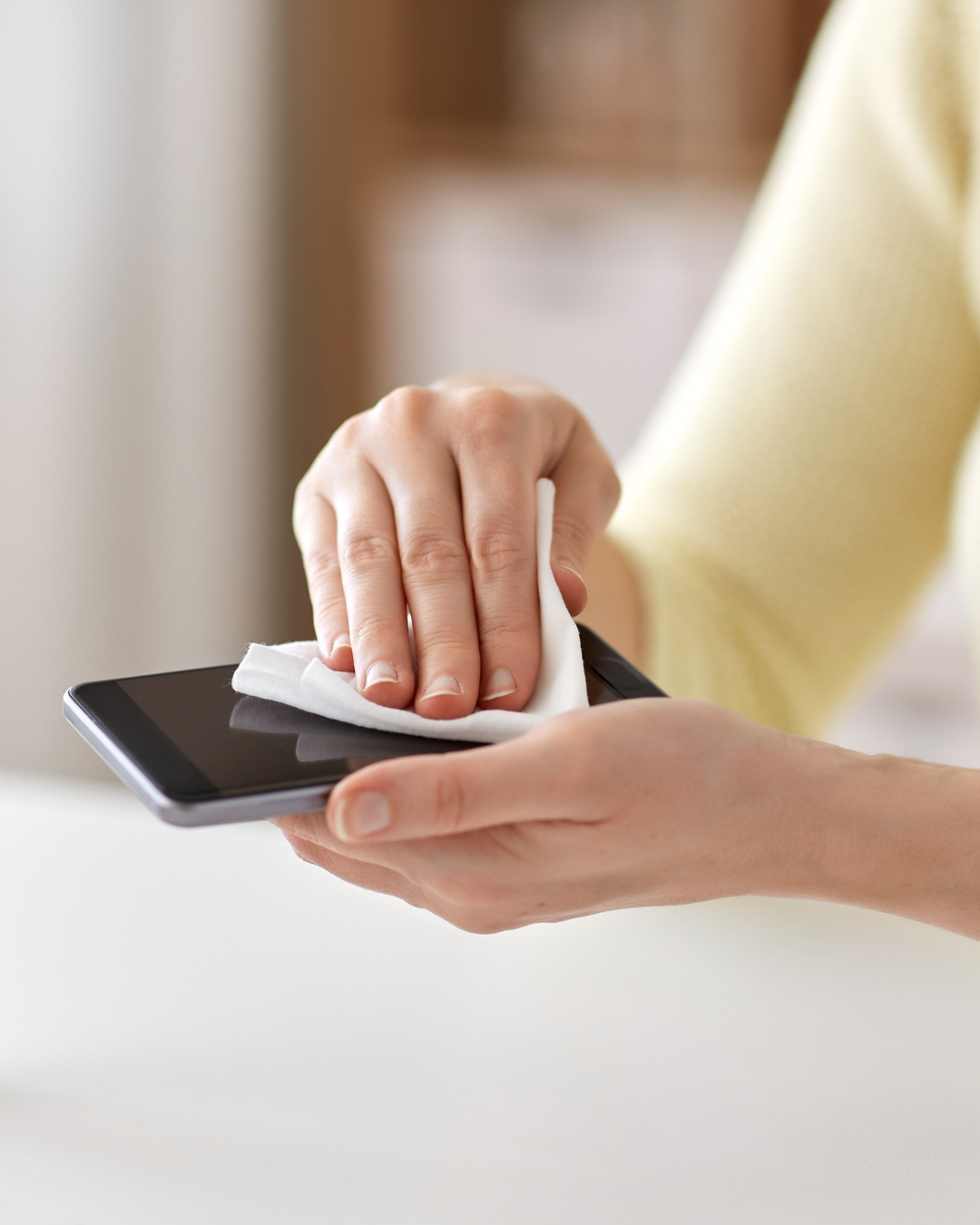3 Ways to Disinfect Your Phone

How to sanitize and disinfect your phone effectively and easily
You’ve got your phone out when someone next to you sneezes. Yuck! With threats like coronavirus, germs, or even unsanitary environments — ever use your phone in the bathroom? — you might wonder, “How often should I clean my phone?”
Handheld devices are famous for picking up germs and bacteria that could carry unseen threats. We’ll explain how to sanitize and disinfect your phone effectively and easily, using methods from UV light sanitizers to classic soap and water.
Why Sanitize Your Phone
Your phone is dirtier than it appears. Beyond being a fingerprint magnet, it harbors numerous germs, bacteria, and even viruses due to frequent contact with hands and various surfaces throughout the day. While many of these microorganisms are harmless, some can cause illness. For example, after washing your hands, touching a public doorknob, and then handling your phone, your device collects the germs from that doorknob. Understanding how to properly sanitize your phone is essential for protecting yourself and others from potentially harmful microorganisms.
How to Sanitize and Disinfect Your Cell Phone
For this method, you’re going to need a plastic card. This could be a credit card, your driver's license, or even an old gift card. Make sure it’s clean! To get rid of screen protector bubbles with a plastic card, take off your protective phone case, and place your phone on a flat surface. Working from the center to the outer edges of your phone, apply gentle pressure and push the bubbles out using the card’s edge. Push in one direction if you can to ensure a firmer grip.
You might notice that the bubbles just moved to another position or change shape. That’s normal. Just keep working with the card until the bubbles are completely gone. If you have an air bubble in the corner that won’t budge, try using the card to briefly lift the screen protector edge that’s closest to the bubble to remove it. If you’re trying to remove air bubbles from tempered glass screen protectors, this tip works for tempered glass too. Some screen protectors will come with a squeegee to push out bubbles – no card required.
Ditch the Dirt and Debris with Tape
Phones should be cleaned at least once daily due to the high volume of germs they encounter. Several effective methods exist for sanitizing devices:
1. Disinfecting Wipes Disinfecting wipes containing 70% isopropyl alcohol are highly effective. Avoid 100% alcohol or spraying alcohol directly on your phone, as this can cause damage. To sanitize, first wipe down your phone and case to remove visible dirt. Then, use a fresh wipe on all surfaces—including the front, back, sides, and buttons—ensuring contact with the solution, and allow it to dry naturally. Pros: Easy, portable, and convenient. Cons: Can be messy, less environmentally friendly, and may miss spots.
2. UV Light Sanitizers UV light sanitizers offer near-complete disinfection, eliminating up to 99.9% of surface bacteria. To use, remove your phone from its case, place it in the sanitizer, close the lid, and wait for the cleaning cycle to finish (time varies by manufacturer; some take as little as 5 minutes). Pros: Effective, environmentally friendly, can charge the phone simultaneously, and can sanitize other small items. Cons: Requires slightly more time than other methods.
3. Antimicrobial Soap and Water Soap and water can be used carefully without submerging the device. Mix a small amount of antibacterial soap in water, dampen a microfiber cloth, and gently rub all surfaces of the phone, including buttons and seams. Repeat the process to ensure complete coverage, using minimal water and drying as you go. Pros: Cost-effective and convenient. Cons: May miss spots and requires caution to avoid water damage.
These methods provide flexible options for maintaining a clean and sanitary phone while minimizing the risk of damage.
Why Sanitize Your Phone
Your phone is dirtier than it appears. Beyond being a fingerprint magnet, it harbors numerous germs, bacteria, and even viruses due to frequent contact with hands and various surfaces throughout the day. While many of these microorganisms are harmless, some can cause illness. For example, after washing your hands, touching a public doorknob, and then handling your phone, your device collects the germs from that doorknob. Understanding how to properly sanitize your phone is essential for protecting yourself and others from potentially harmful microorganisms.
How to Sanitize and Disinfect Your Cell Phone
For this method, you’re going to need a plastic card. This could be a credit card, your driver's license, or even an old gift card. Make sure it’s clean! To get rid of screen protector bubbles with a plastic card, take off your protective phone case, and place your phone on a flat surface. Working from the center to the outer edges of your phone, apply gentle pressure and push the bubbles out using the card’s edge. Push in one direction if you can to ensure a firmer grip.
You might notice that the bubbles just moved to another position or change shape. That’s normal. Just keep working with the card until the bubbles are completely gone. If you have an air bubble in the corner that won’t budge, try using the card to briefly lift the screen protector edge that’s closest to the bubble to remove it. If you’re trying to remove air bubbles from tempered glass screen protectors, this tip works for tempered glass too. Some screen protectors will come with a squeegee to push out bubbles – no card required.
Ditch the Dirt and Debris with Tape
Phones should be cleaned at least once daily due to the high volume of germs they encounter. Several effective methods exist for sanitizing devices:
1. Disinfecting Wipes Disinfecting wipes containing 70% isopropyl alcohol are highly effective. Avoid 100% alcohol or spraying alcohol directly on your phone, as this can cause damage. To sanitize, first wipe down your phone and case to remove visible dirt. Then, use a fresh wipe on all surfaces—including the front, back, sides, and buttons—ensuring contact with the solution, and allow it to dry naturally. Pros: Easy, portable, and convenient. Cons: Can be messy, less environmentally friendly, and may miss spots.
2. UV Light Sanitizers UV light sanitizers offer near-complete disinfection, eliminating up to 99.9% of surface bacteria. To use, remove your phone from its case, place it in the sanitizer, close the lid, and wait for the cleaning cycle to finish (time varies by manufacturer; some take as little as 5 minutes). Pros: Effective, environmentally friendly, can charge the phone simultaneously, and can sanitize other small items. Cons: Requires slightly more time than other methods.
3. Antimicrobial Soap and Water Soap and water can be used carefully without submerging the device. Mix a small amount of antibacterial soap in water, dampen a microfiber cloth, and gently rub all surfaces of the phone, including buttons and seams. Repeat the process to ensure complete coverage, using minimal water and drying as you go. Pros: Cost-effective and convenient. Cons: May miss spots and requires caution to avoid water damage.
These methods provide flexible options for maintaining a clean and sanitary phone while minimizing the risk of damage.
Tags
Clean Your Phone Sanitize Your Phone Disinfect Your Phone
Loading results...
